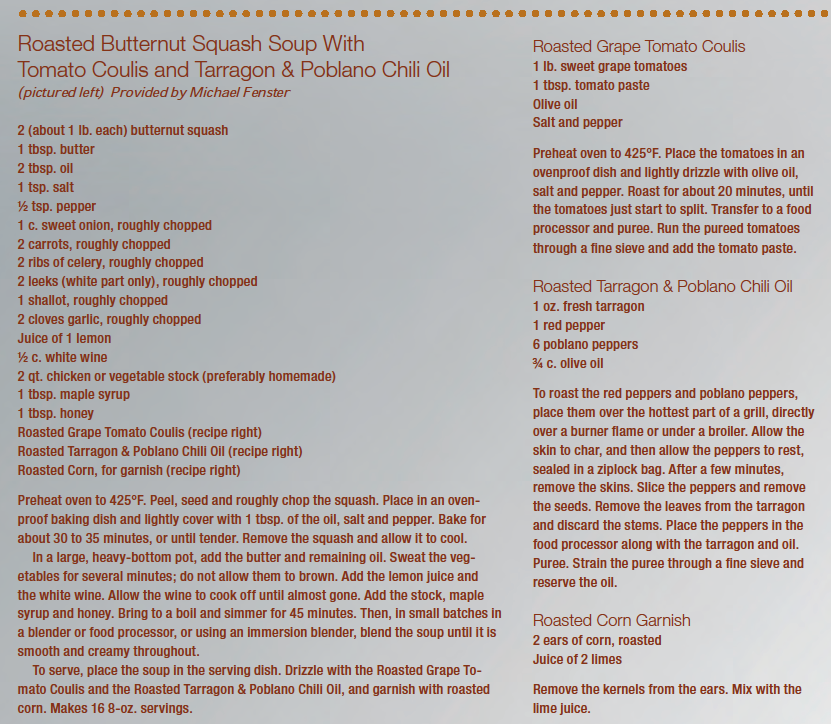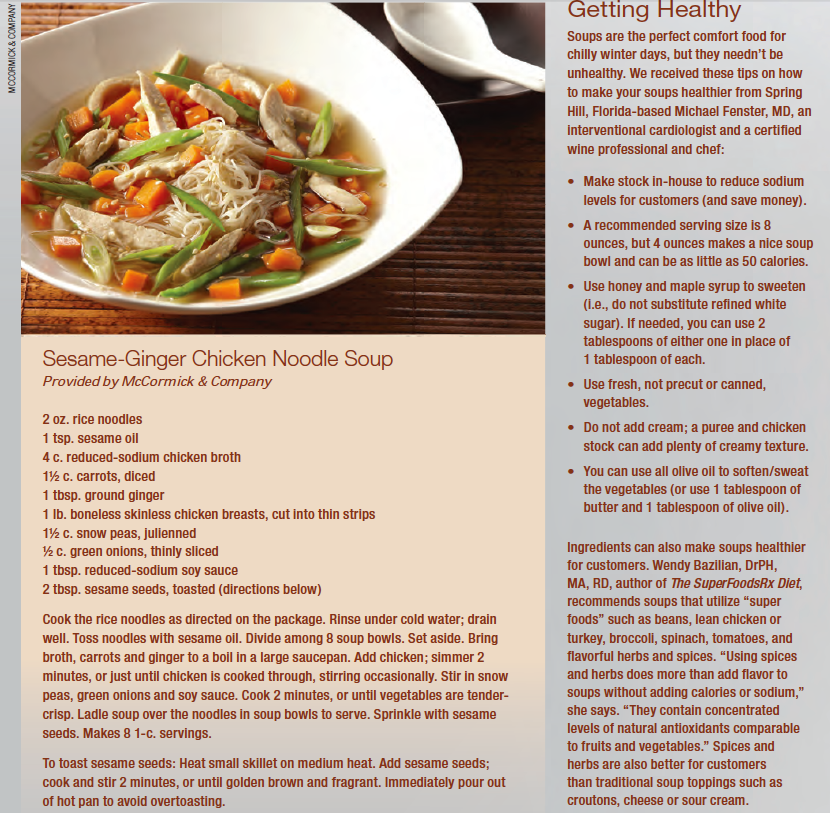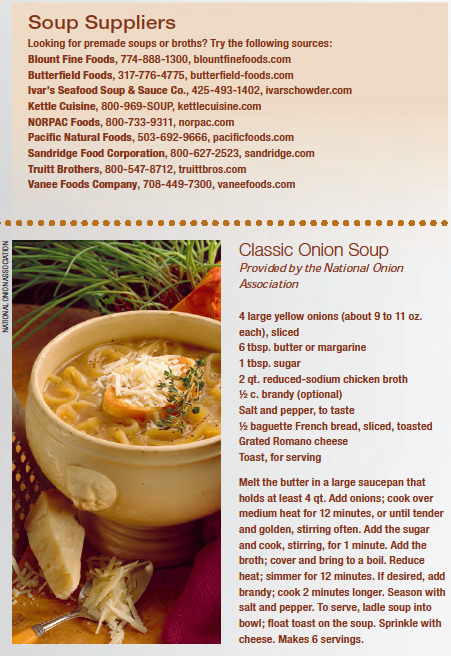Soups are a perfect fit for a pizzeria—after all, they’re about as customizable as pizza and cater to a wide range of taste preferences. You can offer a clear broth-based soup, a creamy bisque or chowder, even a chilled vichyssoise or gazpacho in summertime. Soups can take on any flavor profile, from spicy to soothing, and they also call out to customers who seek a filling yet simple option—particularly when paired with your other menu items. “Our grilled sandwiches and gourmet salads are a large part of our sales, and soup is the perfect accompaniment,” enthuses Cathy Manzon, director of marketing for The Loop Pizza Grill (looppizzagrill.com), based in Jacksonville, Florida, with 13 locations in three states.
With four locations in the greater Kansas City, Missouri, area, SPIN! Neapolitan Pizza (spinpizza.com) co-owner Gail Lozoff agrees that soups make a great add-on to other menu items. “We decided to offer soups because sometimes people come in just for salad, and it rounds out our offerings to provide a soup and salad option.” At SPIN!, a cup of soup and a half salad costs $7.95, a combination that Lozoff calls very profitable. The pizzeria also offers soup bundled with its other entree items, including personal pizzas, sandwiches and salads.
In the Soup
Many appreciate the ease and affordability of offering soups at their establishment. “Customers were asking for soups in the wintertime because of the cold weather, and they’ve become a highlight of our menu—they’re in very high demand, and they sell out every day,” says Mary Beth Akbay, who co-owns Romeo’s Pizzeria & Mediterranean Kitchen (romeos-pizza.com) in Indiana, Pennsylvania, with her husband, Levent. By making her own soup from scratch using ingredients that are already in her kitchen, she keeps costs down and is able to offer fresh, flavorful options that customers can’t get anywhere else. She works from a rotation of about 20 soups, some family recipes, some adapted from others and altered with a few twists. She’ll also change recipes seasonally, working with whatever is freshest (for example, whipping up a butternut squash soup in fall and a chilled tomato gazpacho in summer). Each day, two soups are available for customers: the signature soup, Red Lentil, and a soup of the day. Soups are always served with the restaurant’s homemade bread, upping the value in the eyes of customers.

The Loop Pizza Grill also offers a signature soup and an evolving soup of the day to give customers a couple of options. “Our guests love the signature Tomato Bisque, but because it is a cream-based soup and not a kosher item, some guests prefer a lighter, broth-based soup,” explains Manzon. “Our soup of the day is generally much less than our targeted food cost unless it’s a premium soup, such as the mushroom brie or chicken chili; for a more common soup like chicken noodle or broccoli cheese, it’s about 17% to 23%. The Tomato Bisque is 26% for a cup and 31% for a bowl.” A sign on the counter or wall displays the soups so customers know their options. “Preprinted laminated soup labels state the soup of the day; since they adhere to the sign with Velcro, it’s very easy for the restaurant managers to change them,” she adds.
Of course, analyzing costs will help you decide whether you want to create your own soups from scratch or buy them ready-made. At SPIN!, Lozoff decided to make soups from scratch to lend added flavor and keep costs down. “There are some good premade soups on the market, but we wanted the distinct flavor profile that comes from using our signature roasted vegetables in the recipes,” she says. “Because we pre-roast the vegetables in our custom stone hearth ovens, it’s easy to make our soups, and it’s much less expensive than buying them.” If you do decide to buy premade, you can choose from a range of options, from shelf-stable bases to fully developed soups in a range of varieties, both vegetarian and non-vegetarian. One benefit of stocking premade soups is their extended shelf life; some can keep for months in the refrigerator or more than a year in the freezer.
Of course, you can also add creative garnishes on preprepared soups to give them a homemade feel. Sparks, Maryland-based McCormick & Company suggests the following tips to liven up classic prepared soups (use your imagination to think of more combinations!):
• Give a Tuscan twist to chicken, vegetable or beef soup by stirring in 1/8 teaspoon each of thyme, oregano and crushed rosemary leaves into 2 cups of soup.
• Stir a sprinkle of turmeric into 1 tablespoon of low-fat plain yogurt, then swirl the mixture into butternut squash soup to add a boost of color and flavor.
• Popcorn makes a fun garnish for tomato soup. Try sprinkling hot popcorn with spices such as turmeric, paprika or ground red pepper, then toss a handful on top of each serving.

Souped-Up Sales
Once you’ve added soups to the menu, you can promote them to customers in several ways. Manzon finds that simply putting a visual in the store often helps the soups sell themselves, and therefore invests in in-store signage. “During the winter months, we have a 36” wallboard with beautiful photography of our soups, displayed near the ordering line,” she says. “Guests will point to the photo and say, ‘I want that!’ Food photos really do sell our food.” In addition, the soups may be bundled in a variety of ways—in the summer months, Loop might offer a special that pairs a cup of soup with a wrap or salad, while this month the company is running a campaign that gives away a six-month coupon book with every $25 gift card purchase; January’s coupon is good for a free cup of bisque or soup of the day, no doubt getting many customers to try the soup for the first time.
 Meanwhile, Akbay uses the power of technology to let customers know about the soup of the day. “We send our daily soup text to several hundred people who have signed up to receive soup alerts from us, and this brings people in,” she says. “We also publish our soup of the day on Facebook, which allows us to interact with our customers as well—they’ll ask when’s the next time we’re making a particular soup and give us requests; it’s been a great way to bring customers in and bring them back.” However, she notes, there is one potential pitfall to selling soups: packaging them for delivery and takeout orders. Therefore, the soups are packed in their containers and sealed in their own bags, apart from the remaining food. “We tell pickup customers to be careful with the soup, and have trained our delivery drivers to do the same,” she says. “The last thing people want is to receive their order and find the soup exploded in the bag or all over their other food.” Through proper staff training, however, she has overcome these challenges, ensuring that customers remain satisfied with their soup orders.
Meanwhile, Akbay uses the power of technology to let customers know about the soup of the day. “We send our daily soup text to several hundred people who have signed up to receive soup alerts from us, and this brings people in,” she says. “We also publish our soup of the day on Facebook, which allows us to interact with our customers as well—they’ll ask when’s the next time we’re making a particular soup and give us requests; it’s been a great way to bring customers in and bring them back.” However, she notes, there is one potential pitfall to selling soups: packaging them for delivery and takeout orders. Therefore, the soups are packed in their containers and sealed in their own bags, apart from the remaining food. “We tell pickup customers to be careful with the soup, and have trained our delivery drivers to do the same,” she says. “The last thing people want is to receive their order and find the soup exploded in the bag or all over their other food.” Through proper staff training, however, she has overcome these challenges, ensuring that customers remain satisfied with their soup orders.
Soups can indeed be a welcome addition to your menu, providing extra profits and added options for customers who aren’t in the mood for heavier foods such as pizza or pasta. Whether you make your soups from scratch or buy them premade, or whether you rotate them daily or keep them unchanged, customers will likely eat (or slurp) them up when you serve them with care and add extra perceived value. Finally, marketing your soups as must-haves—in your store, through email or text blasts, or online—will ensure that customers keep coming in. Once you realize the benefits associated with offering soups, you’ll be eager to tell your customers, “Soup’s on!”












